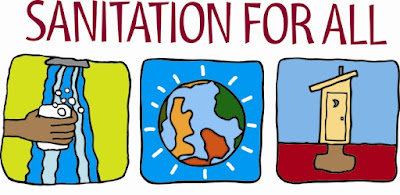Posts
Key Facts of Sanitation
- Get link
- Other Apps

Do you know? In 2015, 39% of the global population (2.9 billion people) used a safely managed sanitation service – defined as use of a toilet or improved latrine, not shared with other households, with a system in place to ensure that excreta are treated or disposed of safely. 27% of the global population (1.9 billion people) used private sanitation facilities connected to sewers from which wastewater was treated. 13% of the global population (0.9 billion people) used toilets or latrines where excreta were disposed of in situ. 68% of the world’s population (5.0 billion people) used at least a basic sanitation service. 2.3 billion people still do not have basic sanitation facilities such as toilets or latrines. Of these, 892 million still defecate in the open, for example in street gutters, behind bushes or into open bodies of water. At least 10% of the world’s population is thought to consume food irrigated by wastewater. Poor sanitation is linked to transmission of diseases
Benefits of Improving Sanitation
- Get link
- Other Apps
Benefits of improved sanitation extend well beyond reducing the risk of diarrhoea. These include: reducing the spread of intestinal worms, schistosomiasis and trachoma, which are neglected tropical diseases that cause suffering for millions; reducing the severity and impact of malnutrition; promoting dignity and boosting safety, particularly among women and girls; promoting school attendance: girls’ school attendance is particularly boosted by the provision of separate sanitary facilities; and potential recovery of water, renewable energy and nutrients from faecal waste. A WHO study in 2012 calculated that for every US$ 1.00 invested in sanitation, there was a return of US$ 5.50 in lower health costs, more productivity, and fewer premature deaths.
Purposes of Sanitation
- Get link
- Other Apps
The overall purposes of sanitation are to provide a healthy living environment for everyone, to protect the natural resources (such as surface water , groundwater , soil ), and to provide safety, security and dignity for people when they defecate or urinate . We also have a human right to sanitation : In September, 2010, the UN Human Rights Council adopted a resolution recognizing that the human right to water and sanitation are a part of the right to an adequate standard of living. Effective sanitation systems provide barriers between excreta and humans in such a way as to break the disease transmission cycle (for example in the case of fecal-borne diseases).This aspect is visualised with the F-diagram where all major routes of fecal-oral disease transmission begin with the letter F: feces, fingers, flies, fields, fluids, food. One of the main challenges is to provide sustainable sanitation , especially in developing countries . Maintaining and sustaining s
Introduction to Sanitation
- Get link
- Other Apps
Sanitation refers to public health conditions related to clean drinking water and adequate treatment and disposal of human excreta and sewage . Preventing human contact with feces is part of sanitation, as is hand washing with soap. Sanitation system aim to protect human health by providing a clean environment that will stop the transmission of disease , especially through the fecal-oral route . For example, diarrhea , a main cause of malnutrition and stunted growth in children, can be reduced through sanitation. There are many other diseases which are easily transmitted in communities that have low levels of sanitation, such as ascariasis (a type of intestinal worm infection or helminthiasis ), cho lera , hepatitis , polio , schistosomiasis , trachoma , to name just a few. The sanitation system A sanitation system includes the capture, storage, transport, treatment and disposal or reuse of human excreta and wastewater . Reuse activities within